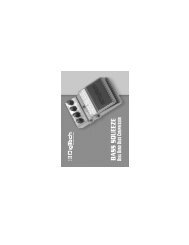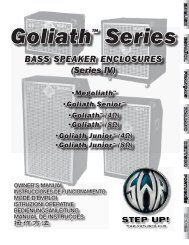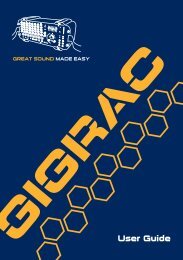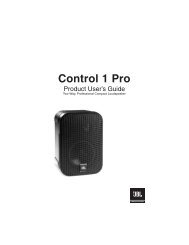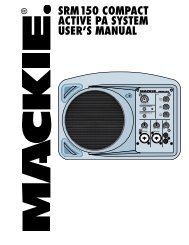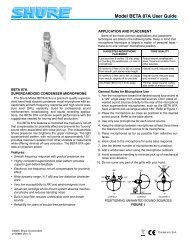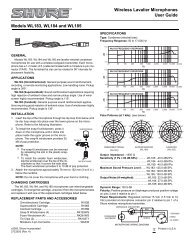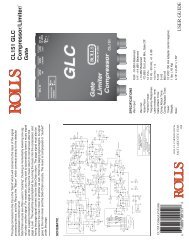Shure Beta 58A Microphone User Guide - Pro Music
Shure Beta 58A Microphone User Guide - Pro Music
Shure Beta 58A Microphone User Guide - Pro Music
You also want an ePaper? Increase the reach of your titles
YUMPU automatically turns print PDFs into web optimized ePapers that Google loves.
Model BETA <strong>58A</strong> ® <strong>User</strong> <strong>Guide</strong><br />
MODEL BETA <strong>58A</strong> ® SUPERCARDIOID DYNAMIC<br />
VOCAL MICROPHONE<br />
APPLICATION AND PLACEMENT<br />
The BETA <strong>58A</strong> is designed for close-up vocals, and can be hand<br />
held or mounted on a stand. Some of the most common applications<br />
and placement techniques are listed in the following table.<br />
Keep in mind that microphone technique is largely a matter of personal<br />
taste; there is no one "correct" microphone position.<br />
SUGGESTED MICROPHONE<br />
PLACEMENT<br />
Lips less than 15 cm (6 in.) away<br />
or touching the windscreen, on<br />
axis to microphone.<br />
15 to 60 cm (6 in. to 2 ft.) away<br />
from mouth, just above nose<br />
height.<br />
TONE QUALITY<br />
Robust sound, emphasized bass,<br />
maximum isolation from other<br />
sources.<br />
Natural sound, reduced bass.<br />
GENERAL<br />
The <strong>Shure</strong> BETA <strong>58A</strong> is a high-output, supercardioid dynamic vocal<br />
microphone for professional sound reinforcement and project<br />
studio recording. It maintains a true supercardioid pattern throughout<br />
its frequency range. This ensures high gain before feedback,<br />
maximum isolation from other sound sources, and minimum offaxis<br />
tone coloration.<br />
The BETA <strong>58A</strong> has a shaped frequency response that is ideal for<br />
close-up vocals. The superb performance of this microphone is not<br />
affected by rough handling because of its rugged construction,<br />
proven shock mount system, and hardened steel mesh grille. Typical<br />
applications for the BETA <strong>58A</strong> include lead vocals, backup vocals<br />
and speech.<br />
FEATURES:<br />
• Frequency response tailored for vocals, with brightened<br />
midrange and bass rolloff to control proximity effect<br />
• Uniform supercardioid pattern for high gain before<br />
feedback and superior rejection of off-axis sound<br />
• Neodymium magnet for high signal-to-noise output<br />
• Hardened steel mesh grille that resists wear and abuse<br />
• Advanced pneumatic shock mount system that minimizes<br />
transmission of mechanical noise and vibration<br />
• Minimally affected by varying load impedance<br />
• Legendary <strong>Shure</strong> quality and reliability<br />
20 to 60 cm (8 in. to 2 ft.) away<br />
from mouth, slightly off to one side.<br />
GENERAL RULES FOR MICROPHONE USE<br />
• Aim the microphone toward the desired sound source and<br />
away from unwanted sources. Since supercardioid<br />
microphones such as the BETA <strong>58A</strong> have narrow pickup<br />
patterns and can pick up sounds from the rear, this may<br />
not be obvious or intuitive.<br />
• Place the microphone as close as practical to the desired<br />
sound source. Refer to the table above.<br />
• Work close to the microphone for extra bass response.<br />
• Use only one microphone to pick up one sound source.<br />
• Keep the distance between microphones at least three<br />
times the distance from each source to its microphone.<br />
• Use the fewest number of microphones as is practical.<br />
• Place microphones as far as possible from reflective<br />
surfaces.<br />
• Add a windscreen when using the microphone outdoors.<br />
• Avoid excessive handling to minimize pickup of<br />
mechanical noise and vibration.<br />
• Do not cover any part of the grille with your hand.<br />
PROXIMITY EFFECT<br />
Natural sound, reduced bass and<br />
minimal "s" sounds.<br />
90 cm to 1.8 m (3 to 6 ft.) away. Thinner, distant sound; noticeable<br />
levels of ambient noise.<br />
Unidirectional microphones such as the BETA <strong>58A</strong> progressively<br />
boost bass frequencies by 6 to 10 dB at 100 Hz when the microphone<br />
is at a distance of about 6 mm (1/4 in.) from the sound<br />
source. This phenomenon, known as proximity effect, can be used<br />
to create a warmer, more powerful sound. To prevent explosive low<br />
frequency sound during close-up use, the BETA <strong>58A</strong> bass response<br />
gradually rolls off. This provides greater control and helps<br />
the user take advantage of proximity effect.<br />
©2005, <strong>Shure</strong> Incorporated<br />
27C2796 (Rev. 5)<br />
Printed in U.S.A.
STAGE MONITOR & P.A. LOUDSPEAKER PLACEMENT<br />
For maximum rejection of unwanted sound, place the stage monitor(s)<br />
or P.A. system loudspeaker at a 60° angle from the rear of<br />
the BETA <strong>58A</strong>, not directly behind it. Always check out the stage<br />
setup before a performance to ensure that microphone and monitor<br />
placement is optimum.<br />
MONITOR<br />
LOUDSPEAKER(S)<br />
120°<br />
90°<br />
180°<br />
120°<br />
P.A. SYSTEM<br />
LOUDSPEAKER<br />
Output Level (at 1,000 Hz)<br />
Open Circuit Voltage: -51.5 dBV/Pa* (2.6 mV)<br />
*1 Pa = 94 dB SPL<br />
Impedance<br />
Rated impedance is 150 Ω (290 Ω actual) for connection to microphone<br />
inputs rated low Z<br />
Phasing<br />
Positive pressure on diaphragm produces positive voltage on<br />
pin 2 with respect to pin 3<br />
GREEN<br />
BLUE<br />
RED<br />
YELLOW<br />
SPECIFICATIONS<br />
0°<br />
RECOMMENDED LOUDSPEAKER LOCATIONS<br />
Type<br />
Dynamic (moving coil)<br />
Frequency Response<br />
50 to 16,000 Hz<br />
NOTE: The curve below shows on-axis response at a distance of 2<br />
feet from a uniform sound source. Your response may vary, depending<br />
on microphone position.<br />
dB<br />
+20<br />
+10<br />
0<br />
–10<br />
-20<br />
2 3 4 5 6 789 2 3 4 5 6 789<br />
20 50 100<br />
1000 10000 20000<br />
Polar Pattern<br />
Supercardioid, rotationally symmetrical about microphone axis,<br />
uniform with frequency<br />
150°<br />
Hz<br />
3 mm (1/8 in)<br />
25 mm (1 in)<br />
51 mm (2 in)<br />
606 mm (2 ft)<br />
TYPICAL FREQUENCY RESPONSE<br />
180°<br />
150°<br />
150°<br />
180°<br />
150°<br />
INTERNAL WIRING<br />
Case<br />
Silver blue enamel-painted die cast metal with hardened, mattefinished,<br />
spherical steel mesh grille<br />
Adjustable, Stand Adapter<br />
Slip-in microphone mounting, unbreakable, adjustable through<br />
180° with standard 5/8"-27 thread, black finish<br />
Dimensions<br />
160 mm<br />
(6.5 in.)<br />
OVERALL DIMENSIONS<br />
Net Weight<br />
278 grams (9.92 oz)<br />
Certification<br />
Eligible to bear CE Marking. Conforms to European EMC Directive<br />
89/336/EEC. Meets applicable tests and performance criteria<br />
in European Standard EN55103 (1996) parts 1 and 2, for<br />
residential (E1) and light industrial (E2) environments.<br />
FURNISHED ACCESSORIES<br />
50 mm<br />
(2 in.)<br />
Adjustable Stand Adapter ...................................... A25D<br />
5/8" to 3/8" (Euro) Thread Adapter ................... 95A2050<br />
Storage Bag .......................................................... 26A21<br />
120°<br />
120°<br />
120°<br />
120°<br />
OPTIONAL ACCESSORIES<br />
90°<br />
60°<br />
30°<br />
90° 90°<br />
–20 dB<br />
–20 dB<br />
–15 dB<br />
–15 dB<br />
–10 dB<br />
60°<br />
60°<br />
–10 dB<br />
–5 dB<br />
–5 dB<br />
30°<br />
30°<br />
30°<br />
0<br />
0<br />
250 Hz<br />
2500 Hz<br />
500 Hz<br />
6300 Hz<br />
1000 Hz<br />
10000 Hz<br />
TYPICAL POLAR PATTERNS<br />
60°<br />
90°<br />
Windscreen...............A58WS Series (8 colors available)<br />
Isolation Mount......................................... A55M, A55HM<br />
7.6 m (25 ft.) Cable ......................................C25E, C25F<br />
REPLACEMENT PARTS<br />
Cartridge .................................................................R176<br />
Grille Assembly..................................................RK265G<br />
Plug (Connector) Assembly .............................. 90F1984<br />
2
MODÈLE BETA <strong>58A</strong> ® MICROPHONE VOCAL<br />
DYNAMIQUE SUPERCARDIOÏDE<br />
GÉNÉRALITÉS<br />
Le <strong>Shure</strong> BETA <strong>58A</strong> est un microphone vocal dynamique supercardioïde<br />
conçu pour la sonorisation professionnelle et les enregistrements<br />
en studio. Il maintient une configuration<br />
supercardioïde réelle dans toute sa gamme de fréquences. Ceci<br />
assure un gain élevé avant Larsen, une isolation maximum des<br />
autres sources sonores et un minimum de coloration de tonalité<br />
hors axe.<br />
La courbe de réponse du BETA <strong>58A</strong> est idéale pour la prise de son<br />
vocale de près. Grâce à sa construction robuste, sa monture antichoc<br />
éprouvée et sa grille en acier trempé, il peut être malmené<br />
sans que sa performance exceptionnelle soit affectée. La sonorisation<br />
des chanteurs et choristes est l'une des applications typiques<br />
du BETA <strong>58A</strong>.<br />
AVANTAGES<br />
• Gamme de fréquences adaptée à la voix avec médiums<br />
extra/clairs et limiteur de basses<br />
• Configuration cardioïde uniforme pour un gain élevé avant<br />
Larsen et rejet supérieur des sons hors axe Aimant au<br />
néodymium pour un rapport signal/bruit élevé Grille en<br />
acier trempé résistante à l'usure et aux mauvais<br />
traitements<br />
• Système antichocs pneumatique avancé réduisant la<br />
transmission des bruits mécaniques et des vibrations<br />
• Faible sensibilité aux changements d'impédance de<br />
charge<br />
• Qualité et fiabilité légendaires de <strong>Shure</strong><br />
APPLICATIONS ET PLACEMENT<br />
Le BETA <strong>58A</strong> est conçu pour la prise de son vocale de près et peut<br />
être tenu à la main ou monté sur pied. Quelques-unes des applications<br />
et techniques de placement les plus courantes sont expliquées<br />
dans le tableau ci-dessous. Ne pas oublier que la technique<br />
de placement des micros est surtout une question de goût personnel<br />
et qu'il n'y a pas de position "correcte".<br />
PLACEMENT SUGGÉRÉ<br />
SONORITÉ<br />
RÈGLES GÉNÉRALES D'UTILISATION DE MICROPHONES<br />
• Diriger le micro vers la source sonore, le plus loin possible<br />
des bruits indésirables. Les angles de captage des<br />
microphones supercardioïdes tels que le BETA <strong>58A</strong> étant<br />
étroits, les bruits de l'arrière peuvent être captés et le<br />
positionnement peut ne pas être évident.<br />
• Placer le microphone aussi près que possible de la source<br />
sonore. Voir le tableau ci-dessus.<br />
• Plus la source sonore est proche du micro, plus les basses<br />
sont présentes.<br />
• N'utiliser qu'un microphone par source sonore.<br />
• La distance entre les microphones doit être d'au moins<br />
trois fois celle de chaque micro à sa source sonore<br />
respective.<br />
• Utiliser le moins de microphones possible.<br />
• Placer les microphones aussi loin que possible des<br />
surfaces réfléchissantes.<br />
• Utiliser un coupe-vent si les microphones sont utilisés à<br />
l'extérieur.<br />
• Éviter les manipulations inutiles pour minimiser le captage<br />
des bruits mécaniques et des vibrations.<br />
• Ne couvrir aucune partie de la grille avec la main.<br />
EFFET DE PROXIMITÉ<br />
Les microphones unidirectionnels tels que le BETA <strong>58A</strong> poussent<br />
progressivement les basses fréquences de 6 à 10 dB à 100 Hz<br />
lorsqu'ils sont placés à environ 6 mm de la source sonore. Ce phénomène,<br />
connu sous le nom d'effet de proximité peut être utilisé<br />
pour créer un son plus chaud et plus puissant. Pour éviter les sons<br />
explosifs de basse fréquence lorsque le microphone est utilisé de<br />
près, la réponse de basses fréquences du BETA <strong>58A</strong> est progressivement<br />
atténuée. Ceci assure un meilleur contrôle et permet à<br />
l'utilisateur de mieux tirer parti de l'effet de proximité.<br />
DISPOSITION DES RETOURS DE SCÈNE ET DES HAUTS-<br />
PARLEURS DE SONORISATION<br />
Pour un réjet maximal des sons indésirables, placer les retours ou<br />
les haut-parleurs à 60° par rapport au microphone BETA <strong>58A</strong> pas<br />
directement derrière. Toujours examiner la mise en place de la<br />
scène pour s'assurer que la disposition des microphones et hautparleurs<br />
est optimale.<br />
Lèvres à moins de 15 cm ou<br />
touchant le coupe-vent, dans l'axe<br />
du micro.<br />
15 à 60 cm de la bouche, juste<br />
audessus de la base du nez.<br />
20 à 60 cm de la bouche<br />
légèrment hors axe.<br />
Son robuste, basses accentuées,<br />
isolation maximum d'autres<br />
sources sonores.<br />
Sonorité naturelle, basses<br />
réduites.<br />
Sonorité naturelle, basses<br />
réduites, sifflements des "s"<br />
minimum.<br />
RETOUR(S)<br />
120°<br />
90°<br />
180°<br />
120°<br />
HAUT-PARLEURS<br />
DE SONORISATION<br />
90 cm à 1,8 m de distance. Petit son, distant, présence<br />
notable de bruits de fond.<br />
0°<br />
PLACEMENT RECOMMANDÉ POUR LES<br />
HAUT-PARLEURS<br />
3
CARACTÉRISTIQUES<br />
Type<br />
Dynamique (bobine mobile)<br />
Courbe de réponse<br />
50 à 16 000 Hz<br />
REMARQUE : la courbe ci-dessous montre la réponse en axe à une<br />
distance de 60 cm d'une source sonore uniforme. La courbe de réponse<br />
peut varier en fonction du placement du microphone.<br />
-20<br />
2 3 4 5 6 789 2 3 4 5 6 789<br />
20 50 100<br />
1000 10000 20000<br />
Courbe de directivité<br />
Supercardioïde, rotativement symétrique autour de l'axe du microphone,<br />
constante avec la fréquence<br />
90°<br />
dB<br />
120°<br />
60°<br />
+20<br />
+10<br />
0<br />
–10<br />
150°<br />
30°<br />
Hz<br />
3 mm (1/8 in)<br />
25 mm (1 in)<br />
51 mm (2 in)<br />
606 mm (2 ft)<br />
COURBE DE RÉPONSE TYPIQUE<br />
180°<br />
–20 dB<br />
–15 dB<br />
–10 dB<br />
–5 dB<br />
0<br />
250 Hz<br />
500 Hz<br />
1000 Hz<br />
150°<br />
30°<br />
120°<br />
60°<br />
90°<br />
90°<br />
120°<br />
60°<br />
150°<br />
30°<br />
180°<br />
–20 dB<br />
–15 dB<br />
–10 dB<br />
–5 dB<br />
COURBES DE DIRECTIVITÉ TYPIQUES<br />
0<br />
150°<br />
30°<br />
2500 Hz<br />
6300 Hz<br />
10000 Hz<br />
120°<br />
60°<br />
90°<br />
Adaptateur de pied réglable, verrouillable<br />
À emboîtement, incassable, réglable à travers 180° avec filet<br />
standard de 5/8"-27. fini noir<br />
Dimensions<br />
Poids net<br />
278 grammes<br />
Homologations<br />
Autorisé à porter la marque CE. Conforme à la directive CEM<br />
européenne 89/336/CEE. Conforme aux critères applicables de<br />
test et de performances de la norme européenne EN 55103<br />
(1996) parties 1 et 2 pour les environnements résidentiels (E1)<br />
et d'industrie légère (E2).<br />
ACCESSOIRES FOURNIS<br />
Adaptateur de pied réglable verrouillable .............. A25D<br />
Adaptateur de filet 5/8 à 3/8 po. (Europe)......... 95A2050<br />
Étui de rangement................................................. 26A21<br />
ACCESSOIRES EN OPTION<br />
Coupe vent Série ............................ A58WS (8 couleurs)<br />
Monture isolante ...................................... A55M, A55HM<br />
Câble de 7,6 m.............................................C25E, C25F<br />
PIÈCES DE RECHANGE<br />
160 mm<br />
(6.5 in.)<br />
DIMENSIONS HORS TOUT<br />
50 mm<br />
(2 in.)<br />
Cartouche ...............................................................R176<br />
Grille...................................................................RK265G<br />
Fiche (connecteur)............................................ 90F1984<br />
Niveau de sortie (à 1000 Hz)<br />
Tension en circuit ouvert : -51,5 dBV* (2,6 mV)<br />
*1 Pa = 94 dB SPL<br />
Impédance<br />
L'impédance nominale est de 150 Ω (290 Ω réelle) pour connexion<br />
aux entrées de micros basse impédance.<br />
Phase<br />
Une pression positive sur le diaphragme produit une tension positive<br />
sur la broche 2 par rapport à la broche 3.<br />
VERT<br />
BLAU<br />
ROUGE<br />
JAUNE<br />
CONNEXIONES INTERNES<br />
Corps<br />
Fonte émaillé bleu argenté avec grille sphérique matte en acier<br />
trempé.<br />
4
MODELL BETA <strong>58A</strong> ® DYNAMISCHES<br />
SUPERNIEREN-TAUCHSPULMIKROPHON FÜR<br />
SPRACHAUFNAHMEN<br />
ALLGEMEINES<br />
Beim <strong>Shure</strong> BETA <strong>58A</strong> handelt es sich um ein dynamisches Supernieren-Tauchspulmikrophon<br />
für Sprachaufnahmen mit hoher Ausgangsleistung,<br />
das für professionelle Tonverstärkung und<br />
Tonstudioaufnahmen entwickelt wurde. Seine echte Supernierencharakteristik<br />
erstreckt sich über den gesamtenFrequenzbereich.<br />
Dadurch werden hohe Verstärkung vor der Rückkopplung, maximale<br />
Isolierung von anderen Schallquellen und minimale außeraxiale<br />
Klangfärbung gewährleistet.<br />
Das BETA <strong>58A</strong> weist ein geformtes Frequenzverhalten auf, das für<br />
Nahaufnahmen von Stimmen ideal ist. Aufgrund seiner robusten<br />
Konstruktion, des bewährten Schwingmetalldämpfer-Systems und<br />
des Gittergrills aus gehärtetem Stahl wird die überragende Leistungsfähigkeit<br />
dieses Mikrophons durch grobe Handhabung nicht<br />
beeinträchtigt. Zu den gebräuchlichsten Einsatzbereichen des<br />
BETA <strong>58A</strong> zählen seine Verwendung durch Hauptsänger und Hintergrundsänger.<br />
MERKMALE<br />
• Auf Sprachaufnahmen zugeschnittenes Frequenzverhalten,<br />
mit aufgehelltem Mittenbereich und Baßdämpfung<br />
• Gleichförmige Supernierencharakteristik für hohe Verstärkung<br />
vor der Rückkopplung und überragende Unterdrükkung<br />
außeraxialer Töne<br />
• Neodym-Magnet für hohe Signalrauschabstandsausgabe<br />
• Gittergrill aus gehärtetem Stahl, widerstandsfähig gegen<br />
Verschleiß und Mißbrauch<br />
• Modernstes pneumatisch Schwingmetalldämpfer-System,<br />
dadurch nur minimale Übertragung von mechanischen<br />
Geräuschen und Vibrationen<br />
• Geringe Empfindlichkeit gegen variable Abschlußimpedanz<br />
• Bewährte <strong>Shure</strong> Qualität und Zuverlässigkeit<br />
ALLGEMEINE REGELN FÜR DEN MIKROPHONGEBRAUCH<br />
• Das Mikrophon auf die gewünschte Tonquelle und weg<br />
von unerwünschten Quellen richten. Da Supernieren- Mikrophone<br />
wie das BETA <strong>58A</strong> eine enge Richtcharakteristik<br />
aufweisen und Töne aus dem Hintergrund aufgreifen können,<br />
ist dies möglicherweise nicht offensichtlich.<br />
• Das Mikrophon so nahe wie möglich an die gewünschte<br />
Tonquelle heranbringen. Siehe obige Tabelle.<br />
• Abstand verringern, wenn zusätzliches Baßverhalten gewünscht<br />
wird.<br />
• Je Tonquelle nur ein Mikrophon verwenden.<br />
• Der Abstand zwischen den Mikrophonen sollte mindestens<br />
dreimal so groß sein wie deren Abstand zu den einzelnen<br />
Quellen.<br />
• Die Anzahl der Mikrophone so gering wie möglich halten.<br />
• Mikrophone so weit wie möglich von Akustikflächen entfernt<br />
anbringen.<br />
• Einen Windschirm anbringen, wenn das Mikrophon im<br />
Freien verwendet wird.<br />
• Mikrophone so wenig wie möglich anfassen, um die Aufnahme<br />
von mechanischen Geräuschen und Vibrationen<br />
minimal zu halten.<br />
• Keinen Teil des Grills mit der Hand abdecken.<br />
NAHEFFEKT<br />
Unidirektionale Mikrophone wie das BETA <strong>58A</strong> bewirken eine progressive<br />
Verstärkung von Baßfrequenzen (um 6 bis 10 dB bei 100<br />
Hz), wenn sich das Mikrophon in einem Abstand von 6 mm von der<br />
Tonquelle befindet. Dieses als Naheffekt bezeichnete Phänomen<br />
kann zur Erzeugung eines wärmeren, kräftigeren Tons verwendet<br />
werden. Zur Verhinderung eines "explosiven" Tons niederer Frequenz<br />
bei Nahaufnahmen wird das Baßverhalten des BETA <strong>58A</strong><br />
allmählich gedämpft. Dies ermöglicht eine bessere Kontrolle und<br />
unterstützt den Benutzer beim Ausnützen des Naheffekts.<br />
ANWENDUNG UND AUFSTELLUNG<br />
Das BETA <strong>58A</strong> ist für Nahaufnahmen von Stimmen vorgesehen<br />
und kann mit der Hand gehalten oder an einem Stativ angebracht<br />
werden. Einige der gebräuchlichsten Anwendungen und Aufstellungsverfahren<br />
sind in der nachfolgenden Tabelle aufgeführt. Beachten<br />
Sie bitte, daß der Mikrophoneinsatz weitgehend eine<br />
"Geschmackssache" ist - von "richtigen" oder "falschen" Mikrophonpositionen<br />
kann hier also nicht die Rede sein.<br />
EMPFOHLENE<br />
MIKROPHONAUF-STELLUNG<br />
Weniger als 15 cm Abstand von<br />
den Lippen oder Berührung des<br />
Windschirms, axial zum<br />
Mikrophon.<br />
15 bis 60 cm Abstand vom Mund,<br />
etwas oberhalb der Nasenhöhe.<br />
20 bis 60 cm Abstand vom Mund,<br />
etwas zur Seite geneigt.<br />
TONQUALITÄT<br />
Robuster Klang,<br />
hervorgehobener Baß, maximale<br />
Isolierung von anderen Quellen.<br />
Natürlicher Klang, reduzierter<br />
Baß.<br />
Natürlicher Klang, reduzierter<br />
Baß und minimale Zischlaute.<br />
90 cm bis 1,8 m Abstand. Dünnerer, entfernterer Klang;<br />
merklicher<br />
Umgebungsgeräuschpegel.<br />
5
AUFSTELLUNG DER BÜHNENLAUTSPRECHER UND<br />
LAUTSPRECHER FÜR BESCHALLUNGSANLAGEN<br />
Zur maximalen Unterdrückung unerwünschter Töne den bzw. die<br />
Bühnenlautsprecher oder den bzw. die Lautsprecher der Beschallungsanlage<br />
in einem Winkel von 60° zur Rückseite des BETA <strong>58A</strong>,<br />
nicht direkt dahinter aufstellen. Vor einem Auftritt stets die Bühnenausstattung<br />
überprüfen, um sicherzustellen, daß die Aufstellung des<br />
Mikrophons und der Bühnenlautsprecher optimal ist.<br />
BÜHNENLAUTSPRECHER<br />
120°<br />
90°<br />
180°<br />
120°<br />
LAUTSPRECHER DER<br />
BESCHALLUNGSANLAGE<br />
Ausgangspegel (bei 1000 Hz)<br />
Leerlaufspannung: -51,5 dBV/Pa* (2,6 mV)<br />
*1 Pa = 94 dB SPL<br />
Impedanz<br />
Die Nennimpedanz für den Anschluß an niederohmige Mikrophoneingänge<br />
beträgt 150 Ω (Ist-Wert 290 Ω)<br />
Phasenabgleich<br />
Positiver Druck auf die Membran erzeugt positive Spannung an<br />
Stift 2 gegenüber Stift 3.<br />
GRÜN<br />
GELB<br />
BLAU<br />
ROT<br />
INTERNE SCHALTUNGEN<br />
EMPFOHLENE LAUTSPRECHERSTELLUNGEN<br />
SPEZIFIKATIONEN<br />
0°<br />
Typ<br />
Dynamisch (Tauchspule)<br />
Frequenzverhalten<br />
50 bis 16.000 Hz<br />
HINWEIS: Die Kurve unten zeigt ein axiales Verhalten in einem Abstand<br />
von 0,6 m von einer gleichförmigen Tonquelle. Das Frequenzverhalten<br />
ist von der Mikrophonstellung abhängig.<br />
-20<br />
2 3 4 5 6 789 2 3 4 5 6 789<br />
20 50 100<br />
1000 10000 20000<br />
Polarcharakteristik<br />
Supernierencharakteristik, rotationssymmetrisch um Mikrophonachse,<br />
gleichförmig mit Frequenz<br />
90°<br />
dB<br />
120°<br />
60°<br />
+20<br />
+10<br />
0<br />
–10<br />
150°<br />
30°<br />
Hz<br />
3 mm (1/8 in)<br />
25 mm (1 in)<br />
51 mm (2 in)<br />
606 mm (2 ft)<br />
TYPISCHES FREQUENZVERHALTEN<br />
180°<br />
–20 dB<br />
–15 dB<br />
–10 dB<br />
–5 dB<br />
0<br />
250 Hz<br />
500 Hz<br />
1000 Hz<br />
150°<br />
30°<br />
120°<br />
60°<br />
90°<br />
90°<br />
120°<br />
60°<br />
150°<br />
30°<br />
180°<br />
–20 dB<br />
–15 dB<br />
–10 dB<br />
–5 dB<br />
TYPISCHE POLARCHARAKTERISTIK<br />
0<br />
150°<br />
30°<br />
2500 Hz<br />
6300 Hz<br />
10000 Hz<br />
120°<br />
60°<br />
90°<br />
Gehäuse<br />
Silberblaues einbrennlackiertes Druckgußmetall mit gehärtetem,<br />
kugelförmigem Stahlgittergrill in matter Oberflächenausführung<br />
Verstellbarer, einrastender Stativadapter<br />
Gleitverbindung, bruchbeständig, durch 180° verstellbar mit<br />
5/8"-27 Standardgewinde, schwarze Oberflächenausführung<br />
Dimensions<br />
Nettogewicht<br />
278 Gramm<br />
Zulassung<br />
Zur CE-Kennzeichnung berechtigt. Entspricht der EU-Richtlinie<br />
über elektromagnetische Verträglichkeit 89/336/EEC. Erfüllt die<br />
Prüfungs- und Leistungskriterien der europäischen Norm EN<br />
55103 (1996) Teil 1 und 2 für Wohngebiete (E1) und Leichtindustriegebiete<br />
(E2).<br />
MITGELIEFERTES ZUBEHÖR<br />
Verstellbarer, einrastender Stativadapter ............... A25D<br />
5/8 zu 3/8 Inch (Euro) Gewindeadapter............ 95A2050<br />
Tasche................................................................... 26A21<br />
SONDERZUBEHÖR<br />
Windschirm ...........A58WS Serie (in 8 Farben erhältlich)<br />
Isolierbefestigung..................................... A55M, A55HM<br />
Kabel, 7,6 m.................................................C25E, C25F<br />
ERSATZTEILE<br />
160 mm<br />
(6.5 in.)<br />
GESAMTABMESSUNGEN<br />
50 mm<br />
(2 in.)<br />
Kapsel.....................................................................R176<br />
Grill-Baugruppe..................................................RK265G<br />
Stecker- (Anschluß-) Baugruppe ...................... 90F1984<br />
6
MODELO BETA <strong>58A</strong> ® MICROFONO DINAMICO<br />
SUPERCARDIOIDE PARA VOCALISTAS<br />
GENERALIDADES<br />
El <strong>Shure</strong> BETA <strong>58A</strong> es un micrófono dinámico de supercardioide<br />
para vocalistas con señal de salida de alta intensidad diseñado<br />
para uso en refuerzo de sonido profesional y en estudios de grabación.<br />
Mantiene un verdadero patrón supercardioide en toda su<br />
gama de frecuencias. Esto asegura un alto valor de ganancia antes<br />
de realimentación, aislamiento máximo de otras fuentes sonoras<br />
y una coloración mínima de los tonos fuera de su eje principal.<br />
El BETA <strong>58A</strong> tiene una respuesta de frecuencia cuya forma es<br />
ideal para que un vocalista lo utilice de cerca. El rendimiento superior<br />
de este micrófono no se ve afectado por el trato duro debido a<br />
su resistente fabricación, su comprobado sistema de montaje a<br />
prueba de choques y su rejilla de malla de acero endurecido. Los<br />
usos típicos del BETA <strong>58A</strong> incluyen la captación de voces principales<br />
y de fondo.<br />
CARACTERISTICAS<br />
• Respuesta de frecuencia diseñada para la voz humana<br />
con aumento de frecuencias medias y atenuación<br />
progresiva de frecuencias bajas<br />
• Patrón de supercardioide uniforme para lograr un alto<br />
valor de ganancia antes de realimentación y un rechazo<br />
superior de los sonidos fuera del eje principal de captación<br />
• El imán de neodimio produce una salida con alta relación<br />
• de señal a ruido<br />
• La rejilla de acero endurecido resiste el desgaste y abuso<br />
• El sistema neumático de montaje contra choques reduce<br />
al mínimo la transmisión de ruido mecánico y vibraciones<br />
• Minimalmente afectado por las variaciones de la<br />
impedancia de carga<br />
• La legendaria calidad y confiabilidad de <strong>Shure</strong><br />
USOS Y COLOCACION<br />
El BETA <strong>58A</strong> está diseñado para captar voces a corta distancia y<br />
puede sostenerse en la mano o en un pedestal. Algunas de las<br />
técnicas más comunes de uso y colocación se indican en la tabla<br />
siguiente. Recuerde que la técnica de uso de los micrófonos es en<br />
gran parte cuestión de gusto personal-no existe una posición de<br />
micrófono que sea la "correcta".<br />
COLOCACION SUGERIDA DEL<br />
MICROFONO<br />
Los labios a no más de 15 cm de<br />
la paravientos, en línea con el eje<br />
de captación del micrófono.<br />
De 15 a 60 cm de la boca, justo<br />
arriba del nivel de la nariz.<br />
De 20 a 60 cm de la boca,<br />
ligeramente a un lado de ésta.<br />
CALIDAD DEL TONO<br />
Sonido robusto, frecuencias<br />
bajas enfatizadas, aislamiento<br />
máximo de otras fuentes sonoras.<br />
Sonido natural, frecuencias bajas<br />
reducidas.<br />
Sonido natural, frecuencias bajas<br />
reducidas y pocos sonidos<br />
sibilantes.<br />
REGLAS GENERALES DE USO DE MICROFONOS<br />
• Coloque el micrófono hacia la fuente sonora deseada y<br />
alejado de las fuentes no deseadas. Debido a que los<br />
micrófonos supercardioide tales como el BETA <strong>58A</strong> tienen<br />
patrones de captación angostos y son capaces de captar<br />
sonidos por su parte trasera, esto podría no ser obvio ni<br />
evidente.<br />
• Coloque el micrófono lo más cerca posible a la fuente<br />
sonora deseada. Consulte la tabla arriba dada.<br />
• Acérquese al micrófono para obtener mayor respuesta de<br />
frecuencias bajas.<br />
• Utilice sólo un micrófono para captar una fuente sonora.<br />
• La distancia entre un micrófono y otro deberá ser al menos<br />
tres veces la distancia de cada fuente a su micrófono.<br />
• Utilice el menor número de micrófonos que resulte<br />
práctico.<br />
• Aleje los micrófonos lo más posible de las superficies<br />
reflectoras.<br />
• Instale una paravientos si se usa el micrófono a la<br />
intemperie.<br />
• Evite el manejo excesivo para reducir la captación de<br />
ruidos mecánicos y vibraciones.<br />
• No cubra parte alguna de la rejilla con la mano.<br />
EFECTO DE PROXIMIDAD<br />
Los micrófonos unidireccionales tales como el BETA <strong>58A</strong> introducen<br />
un aumento progresivo en las frecuencias bajas de 6 a 10 dB<br />
a 100 Hz cuando el micrófono se coloca a aprox. 6 mm de la fuente<br />
sonora (vea la Figura 2). Este fenómeno, conocido como el efecto<br />
de proximidad, puede usarse para crear un sonido más cálido y<br />
fuerte. Para evitar sonidos de baja frecuencia con intensidad explosiva<br />
al usar el micrófono de cerca, el BETA <strong>58A</strong> tiene una atenuación<br />
progresiva en su respuesta de bajos. Esto ofrece mayor<br />
control sobre el sonido y ayuda al usuario a aprovechar el efecto<br />
de proximidad.<br />
COLOCACION DE ALTOPARLANTES DE MONITOREO Y DEL<br />
SISTEMA DE REPRODUCCION<br />
Para el rechazo máximo del sonido no deseado, coloque el o los<br />
altoparlantes de monitoreo o del sistema de reproducción a un ángulo<br />
de 60° respecto a la parte trasera del micrófono BETA <strong>58A</strong>;<br />
no los coloque directamente detrás de éste (vea la Figura 1).<br />
Siempre compruebe la disposición del escenario antes de una ejecución<br />
para verificar que la colocación de micrófonos y altoparlantes<br />
es la óptima.<br />
ALTOPARLANTE(S)<br />
DE MONITOREO<br />
120°<br />
90°<br />
180°<br />
120°<br />
ALTOPARLANTE<br />
DEL SISTEMA DE<br />
REPRODUCCION<br />
De 90 cm a 1,8 m de distancia.<br />
Sonido más agudo y distante;<br />
niveles perceptibles de sonido<br />
ambiental.<br />
0°<br />
COLOCACION RECOMENDADA DE ALTOPARLANTES<br />
7
ESPECIFICACIONES<br />
Tipo<br />
Dinámico (bobina móvil)<br />
Respuesta de frecuencia<br />
50 a 16.000 Hz NOTA: La curva abajo ilustrada muestra la respuesta<br />
de una fuente sonora uniforme colocada en el eje de captación<br />
a una distancia de 0,6 m. La respuesta obtenida en la práctica<br />
variará según la posición del micrófono.<br />
-20<br />
2 3 4 5 6 789 2 3 4 5 6 789<br />
20 50 100<br />
1000 10000 20000<br />
Patrón polar<br />
Supercardioide, simétrico respecto al eje del micrófono, uniforme<br />
respecto a la frecuencia<br />
90°<br />
dB<br />
120°<br />
60°<br />
+20<br />
+10<br />
0<br />
–10<br />
150°<br />
30°<br />
Nivel de salida (a 1.000 Hz)<br />
Voltaje en circuito abierto: -51,5 dBV/Pa* (2,6 mV)<br />
*1 Pa = 94 dB SPL<br />
Impedancia<br />
La impedancia nominal es de 150 Ω (real: 290 Ω) para conexión<br />
a entradas de micrófono de baja impedancia (baja Z)<br />
Fasaje<br />
Una presión positiva en el diafragma del micrófono produce un<br />
voltaje positivo en la clavija 2 con respecto a la clavija 3<br />
Hz<br />
3 mm (1/8 in)<br />
25 mm (1 in)<br />
51 mm (2 in)<br />
606 mm (2 ft)<br />
RESPUESTA DE FRECUENCIA TIPICA<br />
180°<br />
–20 dB<br />
–15 dB<br />
–10 dB<br />
–5 dB<br />
0<br />
250 Hz<br />
500 Hz<br />
1000 Hz<br />
150°<br />
30°<br />
120°<br />
60°<br />
90°<br />
90°<br />
120°<br />
60°<br />
150°<br />
30°<br />
180°<br />
–20 dB<br />
–15 dB<br />
–10 dB<br />
–5 dB<br />
0<br />
150°<br />
30°<br />
2500 Hz<br />
6300 Hz<br />
10000 Hz<br />
PATRONES DE CAPTACION POLAR TIPICOS<br />
VERDE<br />
AZUL<br />
ROJO<br />
120°<br />
60°<br />
90°<br />
Adaptador para pedestal ajustable<br />
Ajustable a través de 180° , irrompible, con rosca estándar de<br />
5/8"-27 y acabado en negro<br />
Dimensiones<br />
Peso neto<br />
278 g<br />
Certificaciones<br />
Califica para llevar las marcas CE. Cumple la directiva europea<br />
89/336/EEC de compatibilidad electromagnética. Se ajusta a los<br />
criterios correspondientes de verificación y funcionamiento establecidos<br />
en la norma europea EN 55103 (1996), partes 1 y 2,<br />
para zonas residenciales (E1) y zonas de industria ligera (E2).<br />
ACCESORIOS SUMINISTRADOS<br />
Adaptador ajustable para pedesta ......................... A25D<br />
Adaptador de roscas de 5/8 a 3/8 pulg (Euro) .. 95A2050<br />
Bolsa de almacenamiento..................................... 26A21<br />
ACCESORIOS OPCIONALES<br />
Paravientos Serie........ A58WS (disponible en 8 colores)<br />
Montaje con aislamiento .......................... A55M, A55HM<br />
Cable de 7,6 m.............................................C25E, C25F<br />
REPUESTOS<br />
160 mm<br />
(6.5 in.)<br />
DIMENSIONES TOTALES<br />
50 mm<br />
(2 in.)<br />
Cartucho .................................................................R176<br />
Conjunto de rejilla ..............................................RK265G<br />
Conjunto de enchufe (conector)........................ 90F1984<br />
AMARILLO<br />
CONEXIONES INTERNAS<br />
Caja<br />
Metal troquelado pintado de color plateado azul con rejilla esférica<br />
de acero endurecido con acabado mate<br />
8
MODELLO BETA <strong>58A</strong> ® MICROFONO VOCALE<br />
DINAMICO A SUPERCARDIOIDE<br />
INTRODUZIONE<br />
Il modello BETA <strong>58A</strong> della <strong>Shure</strong> è un microfono vocale dinamico a supercardioide<br />
ad uscita elevata, realizzato per applicazioni in studi di registrazione<br />
ed impianti di amplificazione professionali. La caratteristica<br />
di ricezione a supercardioide rimane invariata in tutto il campo di frequenza<br />
del microfono, assicurando così un elevato guadagno a monte<br />
della retroazione, massimo isolamento acustico e minima colorazione<br />
dei toni fuori asse.<br />
L'andamento della risposta in frequenza del modello BETA <strong>58A</strong> è ideale<br />
per applicazioni vocali in cui il microfono venga tenuto estremamente<br />
vicino alle labbra. Grazie alla sua costruzione robusta, al sistema comprovato<br />
di montaggio antivibrazione e alla griglia in acciaio temprato, un<br />
uso aggressivo del microfono non influisce sulle sue eccellenti prestazioni.<br />
Applicazioni tipiche del modello BETA <strong>58A</strong> includono l'uso sia da<br />
parte di cantanti solisti che del coro di accompagnamento.<br />
Caratteristiche<br />
• Risposta in frequenza ottimizzata per applicazioni vocali, con<br />
aumento della risposta ai toni intermedi e attenuazione a quelli<br />
bassi.<br />
• Diagramma di ricezione a supercardioide uniforme, che presenta<br />
un elevato guadagno a monte della retroazione ed una<br />
reiezione superiore dei suoni fuori asse.<br />
• Magnete al neodimio, per ottenere un elevato rapporto segnale/rumore<br />
all'uscita.<br />
• Griglia in acciaio temprato, resistente all'usura e agli abusi.<br />
• Avanzato sistema di montaggio antivibrazione pneumatico,<br />
che riduce al minimo la trasmissione di vibrazioni e suoni di<br />
natura meccanica.<br />
• Bassa sensibilità a variazioni dell'impedenza di carico.<br />
• Le leggendarie qualità e affidabilità <strong>Shure</strong>.<br />
APPLICAZIONI E COLLOCAZIONE<br />
Il modello BETA <strong>58A</strong>, realizzato per applicazioni vocali in cui il microfono<br />
si trovi estremamente vicino alle labbra, può essere tenuto in mano<br />
o montato su un supporto. La tabella che segue riporta alcune delle più<br />
comuni applicazioni e tecniche di collocazione. Ricordare sempre che<br />
le tecniche microfoniche dipendono largamente dalle preferenze personali<br />
e che non esiste un'unica posizione "giusta" del microfono.<br />
REGOLE GENERALI PER L'USO DEL MICROFONO<br />
• Rivolgere il microfono verso la sorgente sonora desiderata e<br />
lontano da sorgenti indesiderate. Dato che i microfoni a supercardioide,<br />
come il modello BETA <strong>58A</strong>, presentano diagrammi<br />
di ricezione stretti ed in grado di rilevare suoni provenienti dal<br />
retro, ciò può non essere ovvio né intuitivo.<br />
• Collocare il microfono quanto più vicino possibile alla sorgente<br />
sonora desiderata. Consultare la tabella precedente.<br />
• Per ottenere una maggiore risposta ai toni bassi, tenere il microfono<br />
vicino alle labbra.<br />
• Usare solo un microfono per ciascuna sorgente sonora da ricevere.<br />
• Mantenere la distanza tra più microfoni ad un valore uguale ad<br />
almeno tre volte la distanza tra ciascuna sorgente sonora ed<br />
il corrispondente microfono.<br />
• Usare il numero minimo di microfoni consentito dall'applicazione.<br />
• Collocare i microfoni quanto più lontano possibile da superfici<br />
riflettenti.<br />
• Quando si usa un microfono all'aperto, utilizzare uno schermo<br />
paravento.<br />
• Evitare movimenti eccessivi del microfono, per ridurre al minimo<br />
la ricezione di vibrazioni e suoni di natura meccanica.<br />
• Non coprire nessuna parte della griglia con la mano.<br />
EFFETTO DI PROSSIMITÀ<br />
Nei microfoni unidirezionali, come il modello BETA <strong>58A</strong>, la risposta alle<br />
basse frequenze aumenta progressivamente da 6 a 10 dB a 100 Hz<br />
quando il microfono si trova ad una distanza di circa 6 mm dalla sorgente<br />
sonora. Questo fenomeno, noto come effetto di prossimità, può essere<br />
utilizzato per creare un suono più potente e caldo. Per evitare<br />
suoni esplosivi a basse frequenze durante l'uso ravvicinato, la risposta<br />
del microfono ai toni bassi si attenua gradualmente. Ciò consente un<br />
controllo maggiore ed è di ausilio nello sfruttare l'effetto di prossimità.<br />
COLLOCAZIONE DEGLI ALTOPARLANTI PER LA<br />
DIFFUSIONE SONORA AL PUBBLICO E DI CONTROLLO DEL<br />
PALCOSCENICO<br />
Per ottenere la massima reiezione dei suoni indesiderati, collocare gli<br />
altoparlanti di controllo del palcoscenico o quelli dell'impianto per il pubblico<br />
ad un angolo di 60° rispetto all'asse posteriore del microfono, non<br />
direttamente dietro di esso (vedi Figura 1). Prima della rappresentazione,<br />
controllare sempre l'allestimento del palcoscenico per verificare la<br />
collocazione ottimale del microfono e degli altoparlanti di controllo.<br />
COLLOCAZIONE SUGGERITA<br />
DEL MICROFONO<br />
Labbra a meno di 15 cm dal<br />
microfono o a contatto con lo<br />
schermo paravento, lungo l'asse del<br />
microfono.<br />
Distanza dalle labbra compresa tra<br />
15 e 60 cm, appena sopra l'altezza<br />
del naso.<br />
20 e 60 cm, leggermente fuori asse<br />
sull'uno o l'altro lato.<br />
Distanza compresa tra 90 cm e<br />
1,8 m.<br />
QUALITÀ DEI TONI<br />
Suono robusto, enfasi dei toni<br />
bassi, massimo isolamento da<br />
altre sorgenti.<br />
Suono naturale, toni bassi ridotti.<br />
Suono naturale, toni bassi ridotti<br />
e suoni sibilanti ridotti al minimo.<br />
Suono lontano e affievolito; livelli<br />
evidenti di rumore ambientale.<br />
ALTOPARLANTI DI<br />
CONTROLLO<br />
120°<br />
90°<br />
180°<br />
0°<br />
120°<br />
ALTOPARLANTE<br />
DELL'IMPIANTO<br />
DI DIFFUSIONE<br />
SONORA AL PUB-<br />
BLICO<br />
COLLOCAZIONE SUGGERITA DEGLI ALTOPARLANTI<br />
9
DATI TECNICI<br />
Tipo<br />
Dinamico (bobina mobile)<br />
Risposta in frequenza<br />
Da 50 a 16.000 Hz<br />
NOTA: il grafico che segue mostra la risposta lungo l'asse ad una distanza<br />
di 60 cm da una sorgente sonora uniforme. In una specifica applicazione<br />
la risposta può variare, a seconda della posizione del<br />
microfono.<br />
Adattatore regolabile per supporto<br />
A innesto, senza slittamento, infrangibile, regolabile per 180_<br />
con filettatura standard 5/8"-27, finitura nera<br />
Dimensioni<br />
50 mm<br />
(2 in.)<br />
+20<br />
+10<br />
3 mm (1/8 in)<br />
25 mm (1 in)<br />
51 mm (2 in)<br />
606 mm (2 ft)<br />
160 mm<br />
(6.5 in.)<br />
DIMENSIONI TOTALI<br />
dB<br />
0<br />
–10<br />
-20<br />
2 3 4 5 6 789 2 3 4 5 6 789<br />
20 50 100<br />
1000 10000 20000<br />
Diagramma polare<br />
A supercardioide con simmetria rotazionale rispetto all'asse del<br />
microfono, uniforme con la frequenza<br />
120°<br />
150°<br />
Hz<br />
TIPICA RISPOSTA IN FREQUENZA<br />
180°<br />
150°<br />
120°<br />
120°<br />
150°<br />
180°<br />
150°<br />
120°<br />
CERTIFICAZIONI<br />
Contrassegnabile con il marchio CE. Conforme alla direttiva europea<br />
sulla compatibilità elettromagnetica 89/336/CEE. Conforme<br />
ai criteri sulle prestazioni e alle prove pertinenti specificati<br />
nella norma europea EN 55103 (1996) parti 1 e 2, per ambienti<br />
residenziali (E1) e industriali leggeri (E2).<br />
ACCESSORI IN DOTAZIONE<br />
OPTIONAL<br />
Adattatore regolabile per supporto......................... A25D<br />
Adattatore per filettatura (Euro)<br />
da 5/8 a 3/8 di poll............................................. 95A2050<br />
Fodero................................................................... 26A21<br />
Schermo paravento serie...... A58WS (in 8 diversi colori)<br />
Montatura per isolamento ........................ A55M, A55HM<br />
Cavo, 7,6 m..................................................C25E, C25F<br />
90°<br />
60°<br />
30°<br />
–20 dB<br />
–15 dB<br />
–10 dB<br />
–5 dB<br />
0<br />
30°<br />
60°<br />
90°<br />
90°<br />
60°<br />
30°<br />
–20 dB<br />
–15 dB<br />
–10 dB<br />
–5 dB<br />
0<br />
30°<br />
60°<br />
90°<br />
RICAMBI<br />
Cartuccia.................................................................R176<br />
Gruppo griglia ....................................................RK265G<br />
Gruppo spina (connettore)................................ 90F1984<br />
250 Hz<br />
500 Hz<br />
1000 Hz<br />
TIPICI DIAGRAMMI POLARI<br />
2500 Hz<br />
6300 Hz<br />
10000 Hz<br />
Livelli di uscita (a 1.000 Hz)<br />
Tensione a circuito aperto: -51,5 dBV/Pa* (2,6 mV)<br />
*1 Pa = 94 dB SPL<br />
Impedenza<br />
Valore nominale: 150 Ω (290 Ω effettivi) per il collegamento a ingressi<br />
microfonici con bassi valori nominali di impedenza.<br />
Relazione di fase<br />
Una pressione positiva sul diaframma produce una tensione positiva<br />
al piedino 2 rispetto al piedino 3<br />
VERDE<br />
BLU<br />
ROSSO<br />
GIALLO<br />
COLLEGIAMENTI INTERNI<br />
Contenitore<br />
Corpo in metallo pressofuso con smaltatura blu-argento e griglia<br />
sferica in acciaio temprato con finitura opaca.<br />
10
SHURE Incorporated http://www.shure.com<br />
United States, Canada, Latin America, Caribbean:<br />
5800 W. Touhy Avenue, Niles, IL 60714-4608, U.S.A.<br />
Phone: 847-600-2000 U.S. Fax: 847-600-1212 Intl Fax: 847-600-6446<br />
Europe, Middle East, Africa:<br />
<strong>Shure</strong> Europe GmbH, Phone: 49-7131-72140 Fax: 49-7131-721414<br />
Asia, Pacific:<br />
<strong>Shure</strong> Asia Limited, Phone: 852-2893-4290 Fax: 852-2893-4055


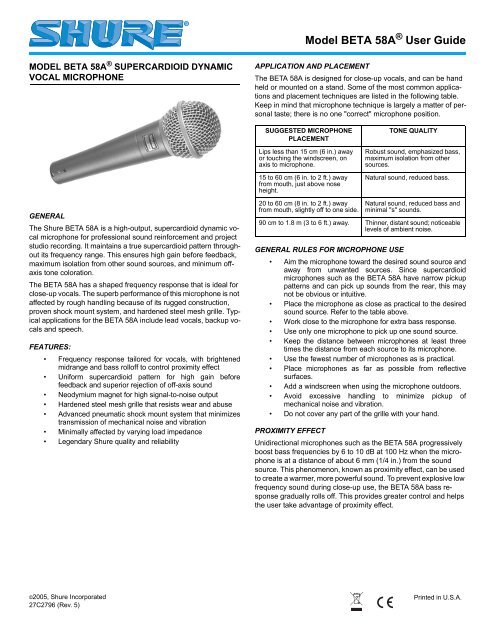
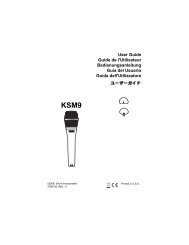
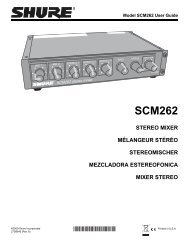
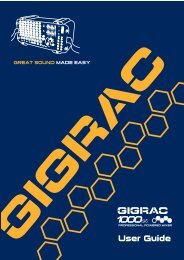
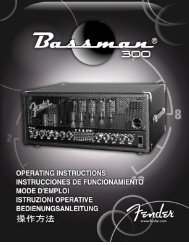
![2 Use the CATEGORY [DEC] / [INC] but - Pro Music](https://img.yumpu.com/43682164/1/190x245/2-use-the-category-dec-inc-but-pro-music.jpg?quality=85)
